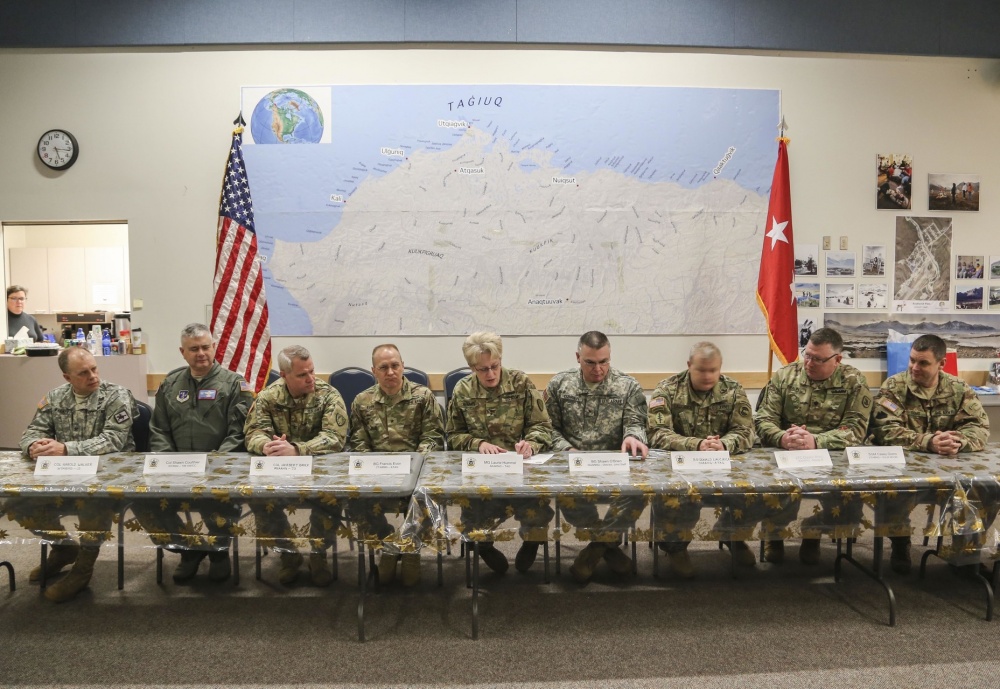Increased activity in warming Arctic piques interest of U.S. National Guard leaders

National Guard officials from more than a fourth of the states say they’re so interested in the future of the Arctic that they want to be part of an Alaska-led effort for training, supplies and operations.
That is why Alaska — the only state with Arctic territory — has joined 14 other states in creating a National Guard Arctic Interest Council.
A preliminary charter signed last week in Utqiaġvik (Barrow) by Guard leaders from some of the 15 states outlines the mission and structure of the new group. The goal is to coordinate and, at times, combine Arctic operations, share expertise and, if needed, stage joint responses with personnel trained and equipped for Arctic conditions.
The charter was signed during an Alaska tour and summit that gathered Guard leaders from several of the signatory states. Participants visited Fairbanks as well as Utqiaġvik.
Arctic experience isn’t new to the Guard units from these states. They have trained in the past with soldiers from Greenland and Canada. “They’re deployed to the Arctic over the years. They find themselves up in the Arctic for their annual training,” said Brig. Gen. Brent Feick, the Alaska National Guard director of joint staff.
What is new is the emphasis on “domestic,” non-combat missions — search-and-rescue work, emergency response and public-safety protection, a contrast to the military and national-security focus of past Arctic training work, Feick said.
“That’s what piqued the interest of the other 14 states,” he said.
Less ice, more potential emergencies

Climate change is the impetus for the 15-state council, he said. Arctic waters have less summer and fall ice and are increasingly open to vessel traffic, he said. The 2016 Northwest Passage cruise of the Crystal Serenity, a large and luxurious passenger ship, was likely just the first such voyage — and the start of more potential emergencies that would require National Guard responses, he said.
That cruise was the inspiration for a disaster-preparedness exercise, Arctic Chinook, that gave more than 1,000 members of the U.S. Coast Guard, the Alaska National Guard and other organizations the opportunity to practice responses to emergencies that might befall cruise ships traveling Arctic waters.
The charter signed in Utqiaġvik on Jan. 25 cites “dramatic changes” caused by Arctic warming.
“Ice-free sea routes are increasingly becoming available and great reserves of previously unreachable oil, gas, and mineral deposits are progressively becoming available for development,” the charter says in its text. “As human activity increases in the region, the likelihood and possible severity of man-made disasters or incidents also increases.”
Shared Arctic expertise
Enter the National Guard, which has “unique capabilities in both equipment and personnel in the Arctic environment,” the charter says.
Banding together is expected to bring benefits to the different states’ Guard operations, Feick said. The hope is that here will be a higher profile for Arctic-focused activities and ambitions.
“It’s better to have one voice instead of having 15,” he said.
Guardsmen in several of the involved states conduct operations in cold or high-altitude environments — in Colorado, for example — so Arctic training and shared Arctic expertise are useful to them, he said.
Benefits can be as simple as sharing advice on what Arctic gear to buy — and what to not buy. The Alaska Army Guard learned the hard way about some equipment shortcomings when its members relied on what were touted as new-and-improved lightweight tents during a springtime training exercise in Utqiaġvik.
The tents were no match for the Arctic winds, said Lt. Col. Aaron Kelsey of the Guard.
“They were just torn to shreds,” he said.
A final agreement between the National Guard Bureau and the adjutant generals from the 15 states is expected later in the year.
Related stories from around the North:
Canada: Canadian military trains to respond to Arctic earthquake, Radio Canada International
Finland: Finnish Air force to take part in joint Finnish-Swedish-US military exercises, Yle News
Norway: Norway patrolling Russia’s military activity in Arctic with new intelligence vessel, The Independent Barents Observer
Russia: Missile complex S-400 on guard in Kola Peninsula, The Independent Barents Observer
Sweden: New security landscape in the Arctic, Radio Sweden
United States: Here’s what’s in the U.S. Defense Department’s new Arctic strategy, Alaska Dispatch News



